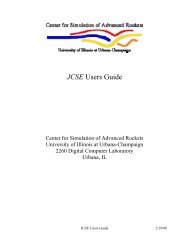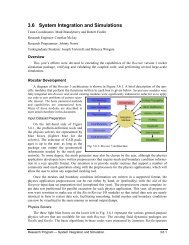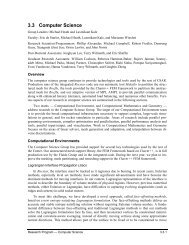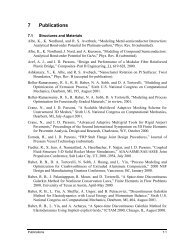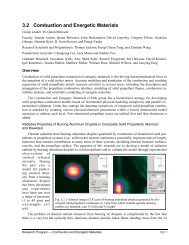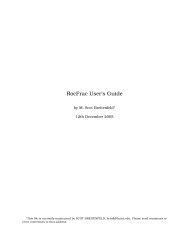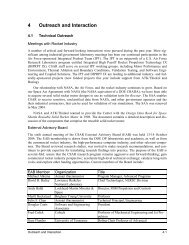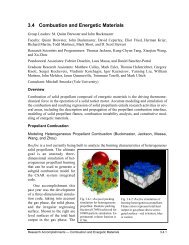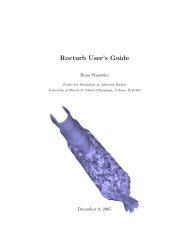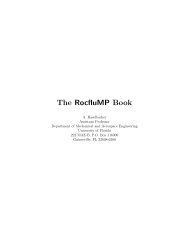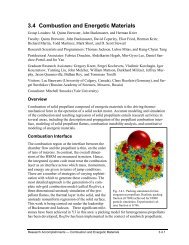3.4 Fluid Dynamics - Center for Simulation of Advanced Rockets
3.4 Fluid Dynamics - Center for Simulation of Advanced Rockets
3.4 Fluid Dynamics - Center for Simulation of Advanced Rockets
You also want an ePaper? Increase the reach of your titles
YUMPU automatically turns print PDFs into web optimized ePapers that Google loves.
<strong>3.4</strong> <strong>Fluid</strong> <strong>Dynamics</strong><br />
Group Leaders: Robert D. Moser, Jr. and S. Balachandar<br />
Faculty: Ronald J. Adrian, S. Balachandar, Jonathan Freund, Robert D. Moser, and S. Pratap Vanka<br />
Research Scientists: Andreas Haselbacher, Fady Najjar and Bono Wasistho<br />
Postdoctoral Associate: Babak Shotorban<br />
Graduate Students: Balakumar Balasubramaniam, Prosenjit Bagchi, Henry Chang, Zhiqun Deng,<br />
Heath Dewey, David Lin, Victor Topalian, Prem Venugopal, Lulama Wakaba, Paulo Zandonade,<br />
Lanying Zeng, Lin Zhang, and Hong Zhao<br />
Overview<br />
The <strong>Fluid</strong> <strong>Dynamics</strong> Group works on system-scale solid rocket motor multiphase compressible core<br />
flow code development, as well as subscale model development relevant to the turbulent dynamics <strong>of</strong><br />
the combustion interface. This includes research projects that will intersect with the integrated code<br />
some time in the future include work in injection, dispersion and combustion <strong>of</strong> aluminum droplets in<br />
the core flow; <strong>for</strong>mation, dispersion and slag accumulation <strong>of</strong> aluminum oxide particles; and flow<br />
within cracks and other defects within the propellant.<br />
Fig. <strong>3.4</strong>.1: Rocflo used to explore vorticity contours in C1x motor downstream <strong>of</strong> inhibitor<br />
Rocflo and Rocflu Development<br />
Rocflo (Wasistho, Balachandar, Moser, Wakaba)<br />
Our structured grid fluids code, Rocflo, is considered mature and is undergoing only minimal<br />
further development. It has been integrated with the full set <strong>of</strong> Rocfluid multiphysics modules, including<br />
turbulence, discrete (Lagrangian) and continuum (Eulerian) particles, radiation, and the interaction<br />
engine governing mass, momentum and energy exchanges between various modules. Rocflo<br />
with all its physical modules is fully integrated<br />
into Rocstar. Example <strong>of</strong> multiphysics simulations<br />
using Rocflo can be seen in C1x simulations<br />
(AIAA 2005-4345), Figure <strong>3.4</strong>.1 and Figure <strong>3.4</strong>.2.<br />
While Rocflu is the primary code <strong>for</strong> use in realistic<br />
solid rocket geometries, Rocflo continues to be<br />
supported because <strong>of</strong> its utility and per<strong>for</strong>mance in<br />
simpler geometries and highly resolved LES<br />
simulations. Recent developments <strong>for</strong> Rocflo include<br />
the completion <strong>of</strong> a dual-timestepping (implicit)<br />
capability and the development <strong>of</strong> an advanced<br />
internal grid motion algorithm, capable <strong>of</strong><br />
simulating fluid-structure interaction problems<br />
involving large de<strong>for</strong>mations with minimal interference<br />
<strong>of</strong> external grid smoothing package, such<br />
as Mesquite. Rocflo internal grid-motion has been<br />
applied to flexible inhibitor simulations in the<br />
Fig. <strong>3.4</strong>.2: Velocity pr<strong>of</strong>ile at x = 0.65m<br />
location <strong>for</strong> clean SP case (solid), inhibitor SP<br />
case (dots), 10 mm MP case (dash), and 30 mm<br />
MP case (dashdot)<br />
Research Program — <strong>Fluid</strong> <strong>Dynamics</strong> <strong>3.4</strong>.1
RSRM (Figure <strong>3.4</strong>.3).<br />
Rocflo as part <strong>of</strong> Rocstar<br />
has also been used in numerous<br />
fluid-structure interaction<br />
simulations, such<br />
as shock panel, ACM<br />
rocket (M. Brandyberry),<br />
and wind past non-rigid<br />
building (D. Turner). Further<br />
enhancement <strong>of</strong> Rocflo<br />
will include incorporation<br />
<strong>of</strong> time-zooming (adding<br />
source terms) and Mesquite<br />
hex-smoothing, implementation<br />
<strong>of</strong> multi-grid<br />
Fig. <strong>3.4</strong>.3: Grid and velocity magnitude at 7ms (left) and at 17ms (right)<br />
method <strong>for</strong> a more efficient dual-timestepping, and implementation <strong>of</strong> new models in multi-physics<br />
modules.<br />
Rocflu (Haselbacher, Balachandar, Moser, Parmar, Zhao)<br />
The unstructured grid flow solver, Rocflu, is nearing completion <strong>of</strong> its core capabilities. Continuing<br />
development is now mainly driven by the requirements specific problems, which may need extensions<br />
or additions to numerical techniques <strong>of</strong> physical models already implemented. Examples include:<br />
• Development <strong>of</strong> a fully implicit Newton-Krylov solver based on PETSc (in collaboration with<br />
Heath Dewey).<br />
• Development <strong>of</strong> non-inertial frame <strong>of</strong> reference <strong>for</strong> the simulation <strong>of</strong> the compressible flow over<br />
an isolated particle accelerated by drag and lift <strong>for</strong>ces<br />
• Incorporation <strong>of</strong> alternative<br />
spatial reconstruction<br />
schemes<br />
• Implementation <strong>of</strong> new<br />
boundary conditions <strong>for</strong><br />
jet flow resonance<br />
simulations.<br />
• Incorporation <strong>of</strong> improved<br />
crack combustion<br />
model (in collaboration<br />
with B. Roe and<br />
L. Massa).<br />
• Implementation <strong>of</strong> parallel<br />
particle-tracking (in collaboration with F. Najjar), completing the integration <strong>of</strong> Rocpart in<br />
Rocflu.<br />
• Detailed verification and substantial improvements in the accuracy <strong>of</strong> the implementation <strong>of</strong> the<br />
Equilibrium Eulerian method.<br />
• Incorporation <strong>of</strong> time-zooming (in collaboration with F. Najjar and L. Massa).<br />
• Conversion from Charm to MPI <strong>for</strong> increased robustness and flexibility.<br />
• Continuing development <strong>of</strong> an incompressible solver<br />
Fig. <strong>3.4</strong>.4: Rocflu used <strong>for</strong> jet flow resonance studies<br />
Research Program — <strong>Fluid</strong> <strong>Dynamics</strong> <strong>3.4</strong>.2
Verification and validation <strong>of</strong> Rocflu has<br />
continued For example, Results produced by<br />
Rocflu compared very well with experimental<br />
results <strong>for</strong> shock diffraction by cylinders and<br />
sharp corners. The growing maturity <strong>of</strong> Rocflu is<br />
reflected in its use in several other research projects:<br />
• Multiphase flow in injector nozzles (Pr<strong>of</strong>. O.<br />
Vasilyev, UC Boulder)<br />
• Jet flow resonance (Pr<strong>of</strong>. J. Freund, UIUC,<br />
AFOSR project; Figure <strong>3.4</strong>.4)<br />
• Compressible multiphase flow in the context<br />
<strong>of</strong> volcanic eruptions (Pr<strong>of</strong>s. S. Kieffer and<br />
S. Balachandar, UIUC)<br />
• Assessment <strong>of</strong> added-mass <strong>for</strong>ces acting on<br />
isolated spherical particles in compressible<br />
flows (Pr<strong>of</strong>. Balachandar, UIUC)<br />
Finally, a number <strong>of</strong> per<strong>for</strong>mance improvements have been pursued (in collaboration with M.<br />
Campbell), in anticipation <strong>of</strong> per<strong>for</strong>ming large and long multi-physics computations. Single-processor<br />
per<strong>for</strong>mance was reduce by about 30%. A further 30-40% improvement in the overall run-time was<br />
achieved by A. Moody and C. Shereda <strong>of</strong> LLNL on the ALC cluster through more aggressive compiler<br />
optimization and more intrusive code tuning techniques. (These changes are currently being run<br />
on plat<strong>for</strong>ms other than ALC to assess plat<strong>for</strong>m-dependency.) Initial scalability studies on uP have<br />
demonstrated good per<strong>for</strong>mance on up to 480 processors.<br />
Verification and Validation<br />
Fig. <strong>3.4</strong>.5: Rocflo per<strong>for</strong>mance is good.<br />
<strong>Simulation</strong>s are being per<strong>for</strong>med using a high resolution, non-dissipative numerical scheme developed<br />
<strong>for</strong> this purpose. The method is based on a staggered grid <strong>for</strong>mulation, which have been<br />
found to have many <strong>of</strong> the advantages exhibited <strong>for</strong> incompressible flows, even <strong>for</strong> the compressible<br />
flows <strong>of</strong> interest here. Ef<strong>for</strong>ts evaluating the Rocstar flow solvers using the test code have focused on<br />
a simplified geometric model <strong>of</strong> the star grain region <strong>of</strong> the propellant. This is a particularly challenging<br />
region to model because the turbulence changes character: inflection instabilities drive the<br />
turbulence in the jet flow that issues from the star grain slot but downstream the flow becomes driven<br />
by the wall conditions. Figure <strong>3.4</strong>.6 shows (a) the streamwise velocity <strong>of</strong> the jet flow just downstream<br />
<strong>of</strong> the star grain, and (b) the streamwise vorticity magnitude at several downstream planes. In this<br />
Fig. <strong>3.4</strong>.6: (a) Streamwise velocity <strong>of</strong> jet flow and (b) steamwise<br />
vorticity magnitude downstream <strong>of</strong> propellant star grain.<br />
Research Program — <strong>Fluid</strong> <strong>Dynamics</strong> <strong>3.4</strong>.3
demonstration, the vorticity features<br />
are barely resolved on the<br />
relatively coarse mesh selected,<br />
yet the algorithm is stable and the<br />
fluctuations are not dissipated by<br />
the numerics.<br />
The main task will be further<br />
development <strong>of</strong> Rocflu as driven<br />
by problems specific problems,<br />
and to apply it to flow problems<br />
with Rocstar. Certain Rocflo enhancements<br />
will also be pursued<br />
as necessary, <strong>for</strong> example an incompressible<br />
capability is being<br />
considered.<br />
Rocstar applications will include<br />
the BATES motors and the<br />
RSRM. Of particular interest will<br />
be RSRM simulations <strong>of</strong> the 4-<br />
segment booster at various burnout<br />
times to assess the effects <strong>of</strong><br />
vortex shedding from the inhibitors<br />
on the acoustics <strong>of</strong> the chamber<br />
as well as on the droplet motion.<br />
In addition, special attention<br />
will be focused on quantifying the<br />
impact angles, diameter, momentum,<br />
temperature, and composition<br />
<strong>of</strong> droplets at the leading edge <strong>of</strong><br />
the submerged nozzle, as well as<br />
the rate <strong>of</strong> accumulation <strong>of</strong> droplets<br />
in the bucket <strong>of</strong> the submerged<br />
nozzle. The resulting statistics will<br />
be <strong>of</strong> great use to the industry in<br />
developing greater understanding<br />
<strong>of</strong> the flow and improved impact<br />
and erosion models.<br />
A second application focus<br />
will be on aeroelastic computations<br />
using the fully implicit<br />
solver currently being incorporated<br />
in Rocflu. This new capability<br />
will allow efficient computations<br />
<strong>of</strong> relatively low-frequency<br />
aeroelastic motions that would<br />
otherwise be inhibited by the stability<br />
limit <strong>of</strong> the explicit solver.<br />
Rocflu will then be extended to<br />
allow <strong>for</strong> a rotating coordinate<br />
systems in preparation <strong>for</strong> com-<br />
Fig. <strong>3.4</strong>.7: Results <strong>for</strong> 15-lb BATES motor configuration <strong>for</strong> 15%<br />
aluminum propellant loading with full-heat release and initial<br />
ejection particle diameter distribution based on pdf distribution<br />
with mean 10mm and minimum and maximum values <strong>of</strong> 5mm and<br />
150 mm:(a) temperature (K), (b) particle positions colored by<br />
particle diameter, (c) smoke concentration.<br />
Fig. <strong>3.4</strong>.8: Results from 3D multiphysics simulations <strong>of</strong> the 15-lb<br />
BATES motor <strong>for</strong> full-heat release with pdf-based initial<br />
distribution. Field contains 133,000 computational droplets<br />
representing 67 million real droplets.<br />
Research Program — <strong>Fluid</strong> <strong>Dynamics</strong> <strong>3.4</strong>.4
puting the flow over a helicopter<br />
blade.<br />
Because <strong>of</strong> the flexibility <strong>of</strong><br />
Rocflu’s data structure, it should<br />
be possible to seamlessly locally<br />
incorporate the structured high<br />
fidelity non-dissipative discretization<br />
used in the verification<br />
code directly into Rocflu. This<br />
will overcome the dissipation<br />
limitations <strong>of</strong> the current algorithm<br />
and greatly increase the<br />
range <strong>of</strong> scientific problems that<br />
it can tackle.<br />
Fig. <strong>3.4</strong>.9: Transverse distributions at the nozzle inlet (x=0.315m):<br />
(a) Aluminum composition, (b) Mass-mean diameter. Solid Line:<br />
15% Al propellant loading, Dashed Line: 21%, Dashed-Dotted Line:<br />
27%.<br />
Multiphysics Framework<br />
and Multiphase Flow<br />
Aluminum Particle Flows (Najjar and Balachandar)<br />
To simulate the complex flow inside an aluminized solid propellant rocket motor, advanced<br />
physical models <strong>for</strong> the evolution <strong>of</strong> turbulence gas flow (Rocflo), burning aluminum Lagrangian<br />
particles (Rocpart), and aluminum-oxide smoke (Rocsmoke) as well as their interactions, are required.<br />
A separate module (Rocinteract) encapsulates the complex interactions amongst the physical components,<br />
and hence simplifies the consistent and conservative transfer <strong>of</strong> mass, momentum and energy.<br />
Recent developments in the multiphysics framework include: A breakup model <strong>for</strong> the Al droplets<br />
based on critical Weber number <strong>for</strong> Rocpart, a Conservative Random Ejection (CRE) to simulate the<br />
random ejection <strong>of</strong> droplets from a surface element while maintaining a conservation constraint, and,<br />
an aluminum combustion model based on aluminum oxide vapor energy <strong>for</strong>malism. The later permits<br />
the full heat release due to burning Lagrangian<br />
particles mechanism without<br />
artificially increasing the gas temperature<br />
beyond the aluminum oxide boiling<br />
point.<br />
In addition to these multiphysics<br />
modeling improvements, the particle<br />
tracking algorithm in Rocpart has been<br />
greatly improved <strong>for</strong> use on unstructured<br />
grids, such as Rocflu. A new algorithm<br />
based on ray tracing is developed<br />
addressing these deficiencies while<br />
maintaining efficiency. The approach<br />
considers the intersections <strong>of</strong> the particle<br />
trajectory with the faces <strong>of</strong> the underlying<br />
grid. Together with a facebased<br />
data structure, the intersection<br />
point on a face directly indicates the cell<br />
into which a particle is moving. By focusing<br />
on intersections with faces, the<br />
algorithm deals with boundaries in a<br />
natural way. Further, efficient memory<br />
management using dynamic memory<br />
Fig. <strong>3.4</strong>.10: Results <strong>for</strong> LP6 motor configuration (1/30-scale<br />
Ariane-V with 50% burnt propellant) using unstructured<br />
fluid solver, Rocflu, and initial injection droplet diameter<br />
distribution based on skewed logarithmic distribution with<br />
mean 23mm and minimum and maximum values <strong>of</strong> 5mm<br />
and 230 mm:(a) spanwise vorticity (1/s), (b) particle<br />
positions colored by particle diameter, (c) number <strong>of</strong> hits <strong>for</strong><br />
droplets impinging on nozzle walls.<br />
Research Program — <strong>Fluid</strong> <strong>Dynamics</strong> <strong>3.4</strong>.5
eallocation has been developed <strong>for</strong><br />
Rocpart. This capability has been extended<br />
to run efficiently in parallel using<br />
MPI. The framework has been enhanced<br />
to handle droplet impingement<br />
on nozzle walls, while capabilities to<br />
track droplets being trapped in the<br />
bucket <strong>of</strong> a submerged nozzle are currently<br />
being pursued. This capability<br />
has been fully integrated into Rocflu<br />
and Rocstar and 3-D simulations <strong>for</strong><br />
various configurations are currently<br />
being per<strong>for</strong>med.<br />
The multiphysics framework is assessed<br />
<strong>for</strong> the 15-lb AFRL BATES<br />
motor configuration. Several propellant<br />
loadings, including 15, 21 and 27%,<br />
have been investigated based on the<br />
BATES firing experiments. Example<br />
results are shown in Figures <strong>3.4</strong>.7-11.<br />
Future Plans The current multiphase<br />
framework will include more<br />
sophisticated physical models, such as<br />
Fig. <strong>3.4</strong>.11: Results <strong>for</strong> 15-lb BATES motor configuration<br />
using unstructured fluid solver, Rocflu: droplet locations at<br />
time instant using single droplet diameter distribution <strong>of</strong><br />
30mm at injection surface.<br />
breakup models, radiation and species. Issues such as particle impingement on nozzle walls, particle<br />
being trapped in the bucket <strong>of</strong> a submerged nozzle are currently being pursued. Of great interest is the<br />
development <strong>of</strong> turbulence-particle LES-based models in terms <strong>of</strong> stochastic equations <strong>for</strong> the particle<br />
velocity field. These issues are been actively studied.<br />
This capability will be expanded to run efficiently in parallel and will be integrated in Rocstar.<br />
Currently, we are assessing the effects <strong>of</strong> superparticle loading on flow dynamics and particle evolution<br />
in the core rocket chamber. Further, we are in the process <strong>of</strong> expanding validation suites <strong>for</strong> MP<br />
problems.<br />
In addition, a number <strong>of</strong> multiphase flow research topics will be pursued. These will include:<br />
• Characterization <strong>of</strong> gas-particle coupling in supersonic accelerating flows, including shockparticle<br />
interaction.<br />
• Characterization <strong>of</strong> droplet impingement on nozzle walls to provide input <strong>for</strong> nozzle ablation<br />
analsis.<br />
• Characterization <strong>of</strong> particle slag accumulation in submerged nozzles.<br />
Microscale <strong>Simulation</strong>s <strong>of</strong> Multiphase Flow (Shotorban and Balachandar)<br />
The flow within the rocket is characterized by a strong streamwise acceleration <strong>of</strong> the mean flow<br />
from the head end to the nozzle. There are also strong shear layers arising from the instability <strong>of</strong> the<br />
injection driven flow, viscous wall response to acoustic oscillations, and vortex shedding <strong>of</strong>f inhibitors.<br />
In the downstream sections <strong>of</strong> the rocket, the flow is strongly turbulent. Despite these complications<br />
the tradition approach to tracking the injected Al droplets is to use a simple drag law, heat transfer<br />
coefficient and burn rate correlation. These correlations are typically developed under conditions<br />
<strong>of</strong> uni<strong>for</strong>m flow and there<strong>for</strong>e their usage in the context <strong>of</strong> multiphase rocket flow is clearly outside<br />
their range <strong>of</strong> applicability. Nevertheless, their use is justified on the basis that there is nothing better<br />
available. The focus <strong>of</strong> the multiphase flow group is there<strong>for</strong>e to rigorously establish the limitations<br />
<strong>of</strong> the standard drag and lift laws and heat transfer coefficients and to suggest improvements that can<br />
Research Program — <strong>Fluid</strong> <strong>Dynamics</strong> <strong>3.4</strong>.6
e incorporated in Rocpart and Rocsmoke to accurately capture the complex multiphase physics relevant<br />
to rocket chamber.<br />
Severals aspects <strong>of</strong> particle-flow interaction have been investigated by the group over the past<br />
year. Here we will highlight only those that pertain to particle-turbulence interaction. Our investigation<br />
shows that freestream turbulence has little systematic effect on time-averaged mean drag. The<br />
standard drag correlation by Schiller & Naumann, when applied based on instantaneous relative velocity,<br />
accurately captures the mean drag. It was observed that the standard drag correlation captures<br />
the instantaneous <strong>for</strong>ce fluctuation only when the particle is sufficiently smaller than the Kolmogorov<br />
scale. In contrast as the size <strong>of</strong> the particle increases the standard drag correlation fails to predict the<br />
actual time-history <strong>of</strong> the drag <strong>for</strong>ce. We believe freestream turbulence induced vortex shedding is<br />
partly responsible <strong>for</strong> such complex behavior. Inclusion <strong>of</strong> additional added-mass and history <strong>for</strong>ces<br />
do not improve comparison. A more productive approach may be to include a stochastic component,<br />
with appropriate statistical properties, to the standard drag law in order to accurately capture particles’<br />
mean motion and dispersion behavior.<br />
Project Plans:<br />
Over the next two years we plan to consider the following activities:<br />
• Extend our prior investigation <strong>of</strong> particle freestream turbulence interaction to the case <strong>of</strong> a freely<br />
moving particle.<br />
• Investigate at the microscale the problem <strong>of</strong> a finite-sized particle moving through a boundary<br />
layer. Here we will consider the cases <strong>of</strong> particle motion through both a laminar shear layer and a<br />
turbulent boundary layer. This is an issue <strong>of</strong> great relevance as it pertains to the question <strong>of</strong> wall<br />
impaction and scouring at the nozzle and entrapment <strong>of</strong> particle in the submerged nozzle.<br />
• We will consider the more complex problem <strong>of</strong> a distribution <strong>of</strong> particles interacting with free<br />
turbulence. These will be first-ever detailed direct numerical simulations <strong>of</strong> multiphase flow turbulence.<br />
The focus will be to investigate the wake-wake and particle-wake interaction on the<br />
<strong>for</strong>ces experienced by the particle and the resulting effect on their motion.<br />
• In the above cases considered we will pay particular attention to the back effect <strong>of</strong> the particles on<br />
carrier phase turbulence. Here the objective will be to encapsulate this back coupling in terms <strong>of</strong><br />
simple models that could be incorporated in Rocturb to account <strong>for</strong> the effect <strong>of</strong> particles on gas<br />
phase turbulence.<br />
Turbulence <strong>Simulation</strong> and Modeling (Moser, Balachandar, Venugopal, and Zandonade)<br />
Large-eddy simulations <strong>of</strong> a solid rocket motor scale model are being per<strong>for</strong>med in order to characterize<br />
the effects <strong>of</strong> turbulence on the sources <strong>of</strong> instabilities. The scale model is based on a cold<br />
gas experimental set-up reproducing the main geometric features <strong>of</strong> a segmented motor. The presence<br />
<strong>of</strong> inhibitors triggers vortex shedding in their wakes while the main flow close to the injection wall<br />
exhibits wall vortex shedding due to hydrodynamic instability. A mesh resolution <strong>of</strong> over 3 million<br />
grid cells is considered; while random turbulence fluctuations with an amplitude <strong>of</strong> 20% is injected<br />
over the mean value to maintain the three-dimensionality characteristics <strong>of</strong> the flow. In Figure <strong>3.4</strong>.12,<br />
it is observed that the flow has reached a fully 3-D state with large-scale vortices breaking down into<br />
small sizes. Further, near-wall structures are seen to evolve similar to the Wall Vortex Shedding<br />
(WSP) phenomenon. It is also clear that the flow is fully turbulent (Figure <strong>3.4</strong>.13).<br />
Optimal LES is a new large eddy simulation approach under development at CSAR. The implementation<br />
<strong>of</strong> Optimal LES <strong>for</strong> use Rocfluid has now progressed to the testing phase. A number <strong>of</strong><br />
modules required to implement the finite volume optimal LES approach have been implemented,<br />
tested (unit tests) and integrated into a stand-alone finite volume code in preparation <strong>for</strong> implementa-<br />
Research Program — <strong>Fluid</strong> <strong>Dynamics</strong> <strong>3.4</strong>.7
tion in Rocflu. The modules have been designed <strong>for</strong> general use to allow integration into other codes<br />
as well.<br />
The primary research concern <strong>for</strong> optimal<br />
LES has been the refinement <strong>of</strong> the dynamic<br />
approach required to provide statistical<br />
in<strong>for</strong>mation that is not available from<br />
theory. It has been found that the errors introduced<br />
by the dynamic procedure can be<br />
catastrophic, producing a model that is unstable.<br />
The difficulty appears to be that the<br />
estimation procedure used to develop the<br />
models is particularly sensitive to the errors.<br />
To counteract this sensitivity, constraints<br />
have been developed to ensure that the resulting<br />
model has the required properties.<br />
The resulting model produces excellent results.<br />
Work is continuing to identify and 13 ms (top) at 1 mm above injection wall, (bottom) in<br />
Fig. <strong>3.4</strong>.12: Isocontours <strong>of</strong> vorticity in x-z plane at t =<br />
correct the source <strong>of</strong> the excessive sensitivity<br />
that results in the need <strong>for</strong> these con-<br />
obstacle wake<br />
straints. By removing the sensitivity, the model will be more general.<br />
Two novel models have been developed <strong>for</strong> the LES <strong>of</strong> particle-laden turbulent flows using a<br />
two-fluid approach. In the first model (LES-Equlibrium model), which is used in the large-eddy<br />
simulation (LES) <strong>of</strong> turbulence, a filtered Eulerian velocity field is defined and computed <strong>for</strong> the<br />
particle phase emloying the equilibrium approximation and then this field is utilized to solve the<br />
filtered particle concentration equation. In the other model (Two-Way-Equilibrium model), in order<br />
to take the effect <strong>of</strong> particle motion on the fluid phase (two-way coupling), the incompressibility<br />
property <strong>of</strong> a mixed velocity field defined based on the volume fractions <strong>of</strong> the particle and gas<br />
phases and their velocities, is used to solve the equations. To valildate the models, the equilibrium<br />
Eulerian <strong>for</strong>mulation is utilized in the homogenous shear turbulence code. The accuracy <strong>of</strong><br />
equilibrium approximation is assessed by comparison <strong>of</strong> the radial distribution function and other<br />
statistical quantities.<br />
Two previously developed<br />
models to account <strong>for</strong> the effect <strong>of</strong><br />
subgrid scales (SGS) on particles in<br />
LES have been modified and<br />
studied with more details. The<br />
proposed Langevin stochastic<br />
equation (Langevin model) has<br />
been modified <strong>for</strong> the inertial<br />
particles and assessed in the Fig. <strong>3.4</strong>.13: Isosurface |w|=8500 s -1 <strong>of</strong> vorticity norm at t = 14 ms<br />
decaying isotropic turbulence. A<br />
good agreement between the model prediction and the exact (DNS) results is obsereved.<br />
Future Plans Detailed 3D LES computations <strong>of</strong> the inhibitor model problem with 4 million grid<br />
points will be pursued <strong>for</strong> various Mach numbers to gain further insight on the flow dynamics. Further<br />
comparison with experiments will be undertaken to substantiate the effects <strong>of</strong> turbulent on the<br />
instability mechanisms.<br />
Research on filtering methods <strong>for</strong> Large-Eddy <strong>Simulation</strong> on unstructured grids in collaboration<br />
with Pr<strong>of</strong>. Oleg Vasilyev will be continued. Issues such as filter-width specification, boundary stencils,<br />
and compact reconstruction methods will be addressed.<br />
Research Program — <strong>Fluid</strong> <strong>Dynamics</strong> <strong>3.4</strong>.8
The continuing optimal LES work will proceed on two parallel tracks. First, model development<br />
and refinement will continue to be pursued. In particular, the refinement <strong>of</strong> the dynamical approach to<br />
eliminate excessive sensitivity to errors will continued, and it is anticipated that this will complete the<br />
development <strong>of</strong> OLES in the absence <strong>of</strong> strong inhomogeneities, such as walls, which is the primary<br />
requirement <strong>for</strong> the rocket flow. For walls, the development <strong>of</strong> the filtered-wall approach, and the<br />
theoretical representation <strong>of</strong> the required correlations are being pursued. The optimal LES implementation<br />
will be tested and completed by incorporating the results <strong>of</strong> the dynamic developments described<br />
above. The Optimal models will be validated against standard turbulent test cases, and ultimately<br />
compared to standard models already implemented in Rocfluid <strong>for</strong> rocket cases. We anticipate<br />
that the first optimal LES models will be ready <strong>for</strong> production use this year.<br />
The LES-Equlibrium, Two-Way-Equilibrium, Langevin and ADM models will be implemented<br />
in RocfluidMP <strong>for</strong> the simulation <strong>of</strong> particle-laden turbulent flows which are encountered in various<br />
applications including solid-propollent rockets. The first two models need to be rigrously validated<br />
first in simple turbulent configurations.<br />
Time Zooming (Moser,<br />
Haselbacher, and Najjar)<br />
An improved <strong>for</strong>mulation <strong>for</strong><br />
time-zooming was developed<br />
based on experience with previous<br />
<strong>for</strong>mulations. The new <strong>for</strong>mulation<br />
explicitly distinguishes<br />
between burn-back and volumefilling<br />
time scales and, being cast<br />
in a finite-volume <strong>for</strong>m, is more<br />
consistent with the Rocflu code.<br />
A dedicated test code was written<br />
based on the quasi-onedimensional<br />
Euler equations to<br />
allow fast turn-around during<br />
testing <strong>of</strong> the new <strong>for</strong>mulation.<br />
The new <strong>for</strong>mulation with<br />
zooming factors <strong>of</strong> about 10-20<br />
was shown to per<strong>for</strong>m very well<br />
Fig. <strong>3.4</strong>.14: Innovative CSAR-developed time zooming algorithms<br />
have been implemented in Rocflu<br />
through comparisons with head-end pressures and chamber pr<strong>of</strong>iles between the zoomed and nominal<br />
computations. The new <strong>for</strong>mulation was also implemented in the 3D Rocflu code and shown to reproduce<br />
nominal results while requiring only one tenth <strong>of</strong> the solution time. Even higher zooming rates<br />
are currently under investigation.<br />
Future Plans The compound zooming <strong>for</strong>mulation will continue to be developed, and tested in the<br />
quasi-one-dimensional test code, and will be moved into Rocflu when it is ready. This should be<br />
within the next several months. For the time-zooming approach to be useful <strong>for</strong> the coupled code, the<br />
<strong>for</strong>mulation will need to be applied in solid mechanics and combustion, and a robust solution to the<br />
moving grid problem will be needed. Implementation and testing <strong>of</strong> time zooming in Rocflu will be<br />
completed, and tested on simple test rockets.<br />
Research Program — <strong>Fluid</strong> <strong>Dynamics</strong> <strong>3.4</strong>.9



